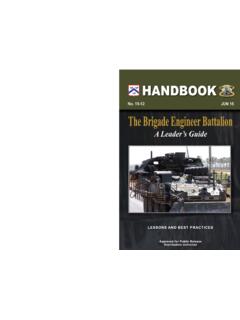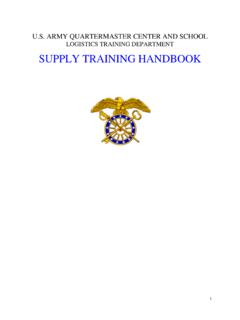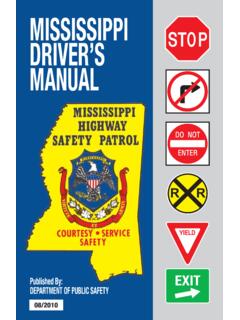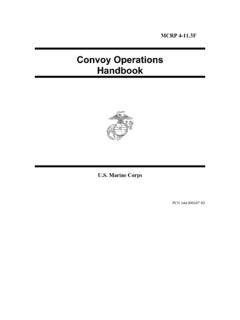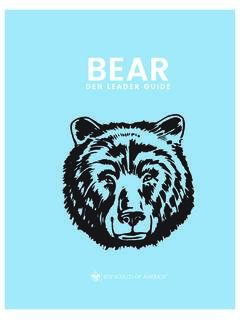Transcription of Ranger Handbook - Seton Hall University
1 SH 21-76 UNITED STATES ARMYRANGER Handbook "NOT FOR THE WEAKOR FAINTHEARTED Ranger TRAINING BRIGADEUNITED STATES ARMY INFANTRY SCHOOLFORT BENNING, GEORGIAAPRIL 2000 TABLE OF CONTENTS I Ranger CREED II STANDING ORDERS ROGER S RANGERS III Ranger HISTORY IV Ranger TRAINING BRIGADE HISTORY CHAPTER 1 LEADERSHIP PRINCIPLES OF LEADERSHIP 1-1 DUTIES/RESPONSIBILITIES 1-2 ASSUMPTION OF COMMAND 1-7 CHAPTER 2 OPERATIONS TROOP LEADING PROCEDURES 2-1 COMBAT INTELLIGENCE 2-7 WARNING ORDER 2-8 OPERATIONS ORDER 2-11 FRAGMENTARY ORDER 2-17 ANNEXES 2-22 COORDINATION CHECKLISTS 2-29 DOCTRINAL TERMS 2-34 CHAPTER 3 FIRE SUPPORT CAPABILITIES 3-2 CLOSE AIR SUPPORT 3-4 CALL FOR FIRE 3-5 CHAPTER 4 MOVEMENT TECHNIQUES 4-2 TACTICAL MARCHES 4-6 DANGER AREAS 4-9 CHAPTER 5 PATROLLING PLANNING CONSIDERATIONS
2 5-1 RECONNAISSANCE OPERATIONS 5-6 COMBAT PATROLS 5-13 AMBUSH 5-14 RAID 5-16 DEPARTURE/RE-ENTRY 5-25 LINK-UP 5-27 PATROL BASE 5-30 MOVEMENT TO CONTACT 5-34 CHAPTER 6 BATTLE DRILLS PLATOON ATTACK 6-1 SQUAD ATTACK 6-5 REACT TO CONTACT 6-8 BREAK CONTACT 6-9 REACT TO AMBUSH 6-11 KNOCK OUT BUNKERS 6-12 ENTER/CLEAR A TRENCH 6-14 BREACH 6-19 CHAPTER 7 COMMUNICATIONS AN/PRC-119 7-1 AN/PRC-126 7-3 CHAPTER 8 ARMY AVIATION AIR ASSAULT 8-1 AIR ASSAULT FORMATIONS 8-3 PZ OPERATIONS 8-5 SAFETY 8-8 CHAPTER 9 WATERBORNE OPERATIONS ONE ROPE BRIDGE 9-1 BOAT POSITIONS 9-8 EMBARKING/DEBARKING 9-11 LANDING SITE 9-11 RIVER MOVEMENT 9-13 FORMATIONS 9-14 CHAPTER 10 MILITARY MOUNTAINEERING SPECIAL EQUIPMENT 10-1 KNOTS 10-2 BELAYS 10-8 TIGHTENING SYSTEMS 10-10 ROCK CLIMBING TECHNIQUES 10-10 RAPPELING 10-14 CHAPTER 11 EVASION/SURVIVAL EVASION 11-1 SURVIVAL 11-1 NAVIGATION 11-2 WATER 11-4 PLANT FOOD 11-5 ANIMAL FOOD 11-6 TRAPS AND SNARES 11-8 SHELTERS 11-17 FIRE BUILDING 11-19 CHAPTER 12 FIRST AID LIFESAVING STEPS 12-1 BITES AND STINGS 12-1 NINE LINE MEDEVAC REQUEST 12-2 HEAD INJURY 12-4 ENVIRONMENTAL INJURIES 12-5 CHAPTER 13 DEMOLITIONS MDI COMPONENTS 13-1 DETONATION SYSTEMS 13-2 DEMOLITION EFFECTS SIMULATOR (DES)
3 13-3 CHAPTER 14 Ranger URBAN OPERATIONS TYPES OF URBAN OPERATIONS 14-1 PRINCIPLES OF URBAN OPERATIONS 14-2 METT-TC CONSIDERATIONS 14-2 CLOSE QUARTERS COMBAT 14-5 BREACHING 14-19 I Ranger CREED Recognizing that I volunteered as a Ranger , fully knowing the hazards of my chosen profession, I will always endeavor to uphold the prestige, honor, and high esprit de corps of the Rangers. Acknowledging the fact that a Ranger is a more elite soldier who arrives at the cutting edge of battle by land, sea, or air, I accept the fact that as a Ranger my country expects me to move further, faster, and fight harder than any other soldier. Never shall I fail my comrades I will always keep myself mentally alert, physically strong, and morally straight and I will shoulder more than my share of the task whatever it may be, one hundred percent and then some.
4 Gallantly will I show the world that I am a specially selected and well trained soldier. My courtesy to superior officers, neatness of dress, and care of equipment shall set the example for others to follow. Energetically will I meet the enemies of my country. I shall defeat them on the field of battle for I am better trained and will fight with all my might. Surrender is not a Ranger word. I will never leave a fallen comrade to fall into the hands of the enemy and under no circumstances will I ever embarrass my country. Readily will I display the intestinal fortitude required to fight on to the Ranger objective and complete the mission, though I be the lone survivor. II STANDING ORDERS ROGERS RANGERS 1. Don't forget nothing. 2. Have your musket clean as a whistle, hatchet scoured, sixty rounds powder and ball, and be ready to march at a minute's warning.
5 3. When you're on the march, act the way you would if you was sneaking up on a deer. See the enemy first. 4. Tell the truth about what you see and what you do. There is an army depending on us for correct information. You can lie all you please when you tell other folks about the Rangers, but don't never lie to a Ranger or officer. 5. Don't never take a chance you don't have to. 6. When we're on the march we march single file, far enough apart so one shot can't go through two men. 7. If we strike swamps, or soft ground, we spread out abreast, so it's hard to track us. 8. When we march, we keep moving till dark, so as to give the enemy the least possible chance at us. 9. When we camp, half the party stays awake while the other half sleeps. 10. If we take prisoners, we keep'em separate till we have had time to examine them, so they can't cook up a story between'em.
6 11. Don't ever march home the same way. Take a different route so you won't be ambushed. 12. No matter whether we travel in big parties or little ones, each party has to keep a scout 20 yards ahead, 20 yards on each flank, and 20 yards in the rear so the main body can't be surprised and wiped out. 13. Every night you'll be told where to meet if surrounded by a superior force. 14. Don't sit down to eat without posting sentries. 15. Don't sleep beyond dawn. Dawn's when the French and Indians attack. 16. Don't cross a river by a regular ford. 17. If somebody's trailing you, make a circle, come back onto your own tracks, and ambush the folks that aim to ambush you. 18. Don't stand up when the enemy's coming against you. Kneel down, lie down, hide behind a tree.
7 19. Let the enemy come till he's almost close enough to touch, then let him have it and jump out and finish him up with your hatchet. MAJOR ROBERT ROGERS 1759 III-1 Ranger HISTORY The history of the American Ranger is a long and colorful saga of courage, daring and outstanding leadership. It is a story of men whose skills in the art of fighting have seldom been surpassed. Only the highlights of their numerous exploits are told here. Rangers primarily performed defensive missions until Benjamin Church s Company of Independent Rangers from Plymouth Colony proved successful in raiding hostile Indians during King Phillip s War in 1675. In 1756 Major Robert Rogers, a native of New Hampshire, recruited nine companies of American colonists to fight for the British during the French and Indian War.
8 Ranger techniques and methods of operation were an inherent characteristic of the American frontiersmen; however, Major Rogers was the first to capitalize on them and incorporate them into the fighting doctrine of a permanently organized fighting force. The method of fighting used by the first Rangers was further developed during the Revolutionary War by Colonel Daniel Morgan, who organized a unit known as Morgan s Riflemen . According to General Burgoyne, Morgan s men were ..the most famous corps of the Continental Army, all of them crack shots. Francis Marion, the Swamp Fox , organized another famous Revolutionary War Ranger element known as Marion s Partisans . Marion s Partisans, numbering anywhere from a handful to several hundred, operated both with and independent of other elements of General Washington s Army.
9 operating out of the Carolina swamps, they disrupted British communications and prevented the organization of loyalists to support the British cause, substantially contributing to the American victory. The American Civil War was again the occasion for the creation of special units such as Rangers. John S. Mosby, a master of the prompt and skillful use of cavalry, was one of the most outstanding Confederate believed that by resorting to aggressive action he could compel his enemies to guard a hundred points. He would then attack one of the weakest points and be assured numerical superiority. With America s entry into the Second World War, Rangers came forth to add to the pages of history. Major William O. Darby organized and activated the 1st Ranger Battalion on June19, 1942 at Carrickfergus, North Ireland.
10 The members were all hand-picked volunteers; 50 participated in the gallant Dieppe Raid on the northern coast of France with British and Canadian commandos. The 1st, 3rd, and 4th Ranger Battalions participated with distinction in the North African, Sicilian and Italian campaigns. Darby s Ranger Battalions spearheaded the Seventh Army landing at Gela and Licata during the Sicilian invasion and played a key role in the subsequent campaign which culminated in the capture of Messina. They infiltrated German lines and mounted an attack against Cisterna, where they virtually annihilated an entire German parachute regiment during close in, night, bayonet and hand-to-hand fighting. III-2 The 2nd and 5th Ranger Battalions participated in the D-Day landings at Omaha Beach, Normandy; it was during the bitter fighting along the beach that the Rangers gained their official motto.




